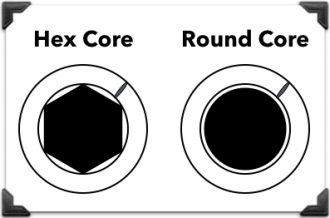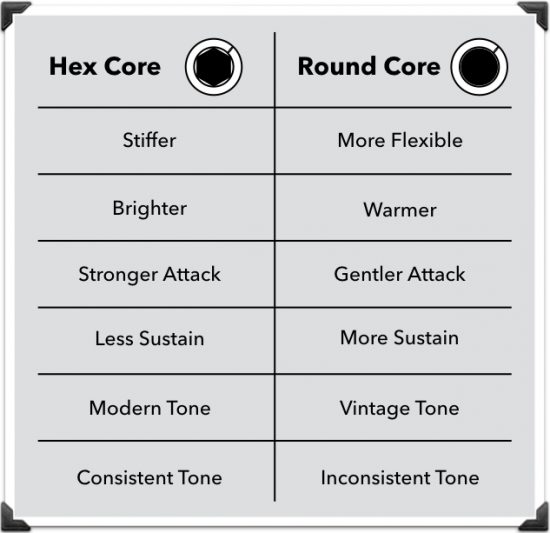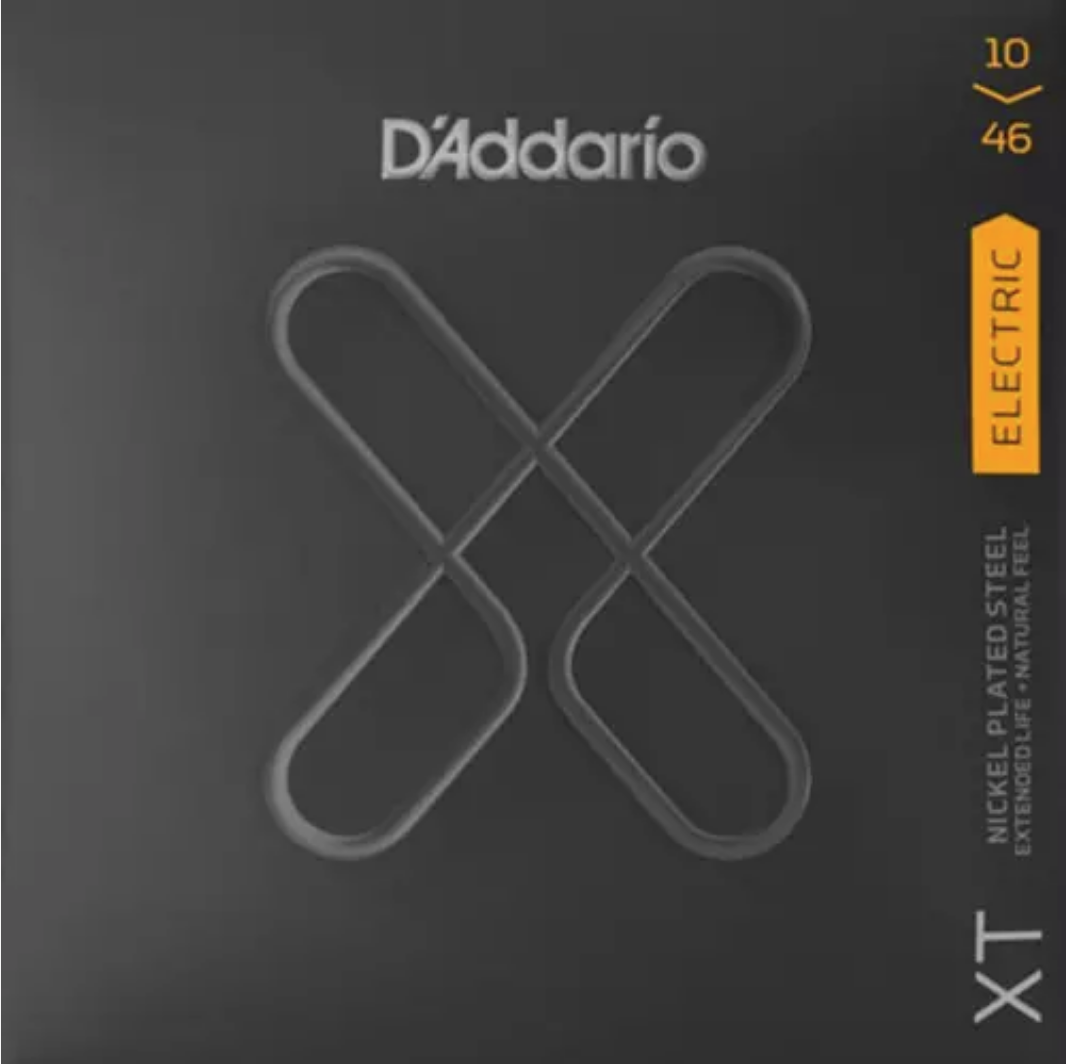
Contemporary Music Instruction and Mentoring
Electric Guitar Strings
There are six things to consider when
buying acoustic guitar strings: gauge, metal composition,
core shape, wound wire shape, coating, and brand.
Let's discuss those four things first, then I will give my
recommendations.
GAUGE
The gauge of the strings tells you how thick they are. Here’s the tradeoff: The thicker the strings are, the the longer they sustain and the better they sound… but they hurt fingers more because they are more difficult to press down onto the fretboard, and they might slow you down in playing fast riffs, but the biggest factor is that they are much harder to bend.
String thickness is measured in 1/1000ths of an inch. The measurements of the string gauges are the same for acoustic and electric guitars. But the names of the string sets are different for electric guitars than for acoustic guitars. Electric guitars use lighter/thinner strings than acoustic guitars. For example, a "light" set of strings for an acoustic guitar is usually .012-.053", where a "light" set of strings for an electric guitar is usually .010-.046".
METAL COMPOSITION
On an acoustic guitar, the two thinnest/highest strings are made of steel with no winding. On an electric guitar, the top three strings are plain steel with no winding. Also, the winding wire on electric guitars is very different from on acoustic guitar. Whereas the winding wire on acoustics is usually either "80/20 bronze” or “phosphor bronze”, the winding wires on electric guitar strings are usually nickel-plated steel (good combination of warmth and brightness), pure nickel (warmer than and not as bright as nickel-plated steel; vintage sound), or stainless steel (less finger squeak, good brightness and sustain).
CORE
The internal core wire around which the outer wire is wound on the bottom three strings may be round or hex:

Back in the 1950s to mid 1970s, all strings were round core. Hex core strings became popular starting in the late 1970s and today the vast majority of electric guitar strings are hex core. The sharp edges of the core wire grip the outer wire, which makes machine wound strings very consistent, because that prevents the winding from slipping and loosening/unwinding. So the quality control is better (no customer complaints of "dead" strings). It also makes the strings brighter, with more attack. The tradeoff is that the round core strings are more flexible, so they "feel" better on your hands, and they have more sustain.

NOTE: There are no worries about installing hex core strings. But if you use round core, it is very important to know that you have to use special techniques when installing round core strings to prevent the windings from unraveling and the string from going dead:
1) make a sharp 90 degree bend in the string with some needlenose pliers at the point where the string goes through the peg hole, and
2) do not trim the excess length off of the string until after it has been tuned to pitch.
(Either of these will probably be sufficient, but I recommend that you do both!)
WOUND WIRE SHAPE
On the bottom three strings, roundwound strings are made by winding normal shaped round wires around the core wire. This gives them a "bumpy" texture under the fingers, which gives better grip when bending strings, and allows "pick scrapes" in classic rock songs. In contrast, flatwound strings are not really wound with wires; they are wound with flat ribbons of metal. This makes them very smooth under the fingers, and gives them a warm, dull sound preferred by many jazz players but not by any classic rock players, because of the dark sound and the lack of sustain. There is also such a thing as "halfround" or "groundwound" strings that are wound with round wires that are then either flattened with rollers or ground flat after the string has been wound, so that the inner part that's touching the core wire is round, but the part that touches your fingers is flat. They are expensive, rare, and pretty much useless. Roundwounds are by far the most popular, the least expensive, have the best variety, and sound the best on 99% of songs.
COATINGS
Normal (non-coated) strings sound good for a short time, then oxygen in the air attacks the brass/bronze, and oil and dirt from your fingers seeps through the windings, which dulls the sound. Coated strings use a microscopic layer of a polymer (usually PTFE / Teflon) that keeps oxygen from attacking the bronze and keeps finger sweat/oil out of the windings. Although I highly recommend coated strings for acoustic guitars, I do not recommend them for electric guitars. They just ruin the tone.
However, D'Addario has come out with a new string that is not coated but it is "treated" for extra life. It is called the XT, and it feels and sounds like a high quality uncoated string but it lasts about twice as long.
BRANDS OF STRINGS
The most popular electric guitar strings are made by D'Addario and Ernie Ball. They both are good brands. Other popular brands that I have no experience with include GHS and DR. (I have used DR strings on bass and they are great!). There are also a couple of less known imported brands that I like. One that my lead guitar player loves is Thomastik-Infeld, which are made in Austria. And my favorite for roundcore pure nickel strings is Pyramid, which is made in Germany.
RECOMMENDATIONS
My personal recommendation for beginners are hex core, roundwound, nickel plated steel, uncoated, light gauge strings, which is the most popular type of string among electric guitar players. The specific brand and model I recommend is D'Addario XT Electric 10-46 (below). The reason I recommend them is because these particular strings have three features that make them better than the rest: First, the core wire is made of D'Addario's proprietary NY Steel, which is far stronger than the normal steel that everyone else uses. This gives them better pitch/tuning stability and also makes them highly resistant to breaking. Second, they are wound with proprietary "Fusion Twist" technology which gives them a resilient tone that is versatile for various genres. Finally, they are not coated with a plastic polymer like "coated" strings, but they have another newer corrosion resistant coating technology that does not interfere with the tone and feel of the strings, so they last longer than uncoated strings but play like uncoated strings.

There’s no right or wrong; it is a matter of individual taste. I personally use Pyramid Nickel Classic 10-48 strings, which are round core, roundwound strings with pure nickel windings. They are also hand-wound rather than machine-wound, which is rare these days. They feel great under my fingers, don't wear out my frets, bend easily, sustain like crazy, and have the tone I like for the music I usually play (rhythm on vintage classic rock). But they would not be as good for lead guitar and for other styles of music. Nobody can tell you what the "best" string is for you. My advice is to start with the XT strings, but over time, as you develop as a performer, you will want to try a bunch of different strings and see what you like.
WHERE TO BUY STRINGS
The local music stores may or may not have the strings you want in stock. If the stores don’t have the set you want, don’t let them talk you into buying what they have on hand. You can ask them to please order the strings you want, or you can always purchase strings at sweetwater.com, stringsandbeyond.com, or juststrings.com, all three of which are very good, honest companies. I personally recommend sweetwater.com for all musical instruments and accessories that are not available locally. They carry all major brands, and also some specialty brands such as Thomastic-Infeld. Pyramid strings are available at juststrings.com.
Do not ever buy strings on Ebay, and be careful on Amazon. Beware of fake, counterfeit, knock off strings for super cheap prices on online retailers (usually around 1/3 the price). They are NOT real. They are made by Chinese scumbags who have no qualms about violating international trademark and patent laws. Anyone who sells them is a scammer who is trying to sell garbage to unsuspecting customers.
HOW TO RESTRING YOUR GUITAR
There are various methods for changing strings, and there are a lot of strongly held but wrong opinions among guitarists as to which is the "best" way. I have tried them all, and have found that the method recommended by Taylor Guitars is by far the easiest, fastest, cleanest, and most tuning-stable of them all, for both acoustic and electric guitars. LINK HERE for a tutorial from Taylor Guitars on how to correctly install strings.
In most cases, you can change brands and types and coatings without re-adjusting your guitar's action, but if you change gauge of strings, you will need to adjust the truss rod in the neck to compensate for the different tension the strings place on the neck. LINK HERE to learn how to do this.
GAUGE
The gauge of the strings tells you how thick they are. Here’s the tradeoff: The thicker the strings are, the the longer they sustain and the better they sound… but they hurt fingers more because they are more difficult to press down onto the fretboard, and they might slow you down in playing fast riffs, but the biggest factor is that they are much harder to bend.
String thickness is measured in 1/1000ths of an inch. The measurements of the string gauges are the same for acoustic and electric guitars. But the names of the string sets are different for electric guitars than for acoustic guitars. Electric guitars use lighter/thinner strings than acoustic guitars. For example, a "light" set of strings for an acoustic guitar is usually .012-.053", where a "light" set of strings for an electric guitar is usually .010-.046".
METAL COMPOSITION
On an acoustic guitar, the two thinnest/highest strings are made of steel with no winding. On an electric guitar, the top three strings are plain steel with no winding. Also, the winding wire on electric guitars is very different from on acoustic guitar. Whereas the winding wire on acoustics is usually either "80/20 bronze” or “phosphor bronze”, the winding wires on electric guitar strings are usually nickel-plated steel (good combination of warmth and brightness), pure nickel (warmer than and not as bright as nickel-plated steel; vintage sound), or stainless steel (less finger squeak, good brightness and sustain).
CORE
The internal core wire around which the outer wire is wound on the bottom three strings may be round or hex:

Back in the 1950s to mid 1970s, all strings were round core. Hex core strings became popular starting in the late 1970s and today the vast majority of electric guitar strings are hex core. The sharp edges of the core wire grip the outer wire, which makes machine wound strings very consistent, because that prevents the winding from slipping and loosening/unwinding. So the quality control is better (no customer complaints of "dead" strings). It also makes the strings brighter, with more attack. The tradeoff is that the round core strings are more flexible, so they "feel" better on your hands, and they have more sustain.

NOTE: There are no worries about installing hex core strings. But if you use round core, it is very important to know that you have to use special techniques when installing round core strings to prevent the windings from unraveling and the string from going dead:
1) make a sharp 90 degree bend in the string with some needlenose pliers at the point where the string goes through the peg hole, and
2) do not trim the excess length off of the string until after it has been tuned to pitch.
(Either of these will probably be sufficient, but I recommend that you do both!)
WOUND WIRE SHAPE
On the bottom three strings, roundwound strings are made by winding normal shaped round wires around the core wire. This gives them a "bumpy" texture under the fingers, which gives better grip when bending strings, and allows "pick scrapes" in classic rock songs. In contrast, flatwound strings are not really wound with wires; they are wound with flat ribbons of metal. This makes them very smooth under the fingers, and gives them a warm, dull sound preferred by many jazz players but not by any classic rock players, because of the dark sound and the lack of sustain. There is also such a thing as "halfround" or "groundwound" strings that are wound with round wires that are then either flattened with rollers or ground flat after the string has been wound, so that the inner part that's touching the core wire is round, but the part that touches your fingers is flat. They are expensive, rare, and pretty much useless. Roundwounds are by far the most popular, the least expensive, have the best variety, and sound the best on 99% of songs.
COATINGS
Normal (non-coated) strings sound good for a short time, then oxygen in the air attacks the brass/bronze, and oil and dirt from your fingers seeps through the windings, which dulls the sound. Coated strings use a microscopic layer of a polymer (usually PTFE / Teflon) that keeps oxygen from attacking the bronze and keeps finger sweat/oil out of the windings. Although I highly recommend coated strings for acoustic guitars, I do not recommend them for electric guitars. They just ruin the tone.
However, D'Addario has come out with a new string that is not coated but it is "treated" for extra life. It is called the XT, and it feels and sounds like a high quality uncoated string but it lasts about twice as long.
BRANDS OF STRINGS
The most popular electric guitar strings are made by D'Addario and Ernie Ball. They both are good brands. Other popular brands that I have no experience with include GHS and DR. (I have used DR strings on bass and they are great!). There are also a couple of less known imported brands that I like. One that my lead guitar player loves is Thomastik-Infeld, which are made in Austria. And my favorite for roundcore pure nickel strings is Pyramid, which is made in Germany.
RECOMMENDATIONS
My personal recommendation for beginners are hex core, roundwound, nickel plated steel, uncoated, light gauge strings, which is the most popular type of string among electric guitar players. The specific brand and model I recommend is D'Addario XT Electric 10-46 (below). The reason I recommend them is because these particular strings have three features that make them better than the rest: First, the core wire is made of D'Addario's proprietary NY Steel, which is far stronger than the normal steel that everyone else uses. This gives them better pitch/tuning stability and also makes them highly resistant to breaking. Second, they are wound with proprietary "Fusion Twist" technology which gives them a resilient tone that is versatile for various genres. Finally, they are not coated with a plastic polymer like "coated" strings, but they have another newer corrosion resistant coating technology that does not interfere with the tone and feel of the strings, so they last longer than uncoated strings but play like uncoated strings.

There’s no right or wrong; it is a matter of individual taste. I personally use Pyramid Nickel Classic 10-48 strings, which are round core, roundwound strings with pure nickel windings. They are also hand-wound rather than machine-wound, which is rare these days. They feel great under my fingers, don't wear out my frets, bend easily, sustain like crazy, and have the tone I like for the music I usually play (rhythm on vintage classic rock). But they would not be as good for lead guitar and for other styles of music. Nobody can tell you what the "best" string is for you. My advice is to start with the XT strings, but over time, as you develop as a performer, you will want to try a bunch of different strings and see what you like.
WHERE TO BUY STRINGS
The local music stores may or may not have the strings you want in stock. If the stores don’t have the set you want, don’t let them talk you into buying what they have on hand. You can ask them to please order the strings you want, or you can always purchase strings at sweetwater.com, stringsandbeyond.com, or juststrings.com, all three of which are very good, honest companies. I personally recommend sweetwater.com for all musical instruments and accessories that are not available locally. They carry all major brands, and also some specialty brands such as Thomastic-Infeld. Pyramid strings are available at juststrings.com.
Do not ever buy strings on Ebay, and be careful on Amazon. Beware of fake, counterfeit, knock off strings for super cheap prices on online retailers (usually around 1/3 the price). They are NOT real. They are made by Chinese scumbags who have no qualms about violating international trademark and patent laws. Anyone who sells them is a scammer who is trying to sell garbage to unsuspecting customers.
HOW TO RESTRING YOUR GUITAR
There are various methods for changing strings, and there are a lot of strongly held but wrong opinions among guitarists as to which is the "best" way. I have tried them all, and have found that the method recommended by Taylor Guitars is by far the easiest, fastest, cleanest, and most tuning-stable of them all, for both acoustic and electric guitars. LINK HERE for a tutorial from Taylor Guitars on how to correctly install strings.
In most cases, you can change brands and types and coatings without re-adjusting your guitar's action, but if you change gauge of strings, you will need to adjust the truss rod in the neck to compensate for the different tension the strings place on the neck. LINK HERE to learn how to do this.